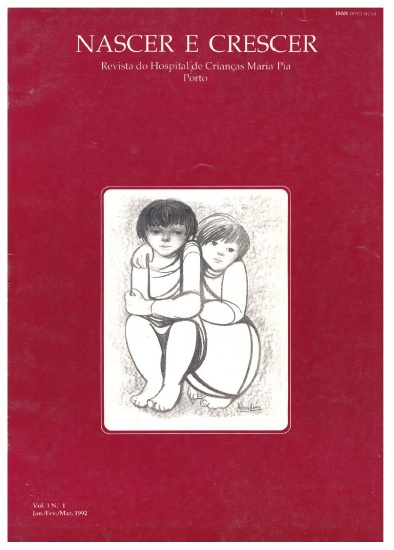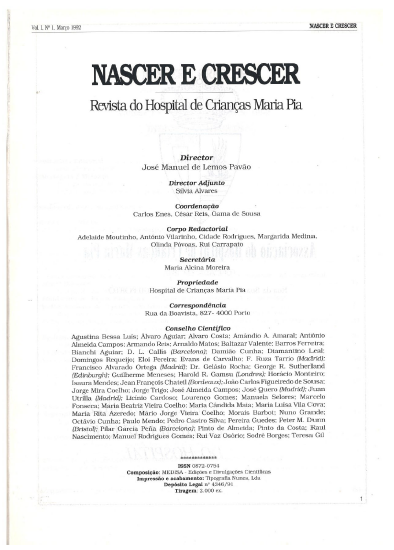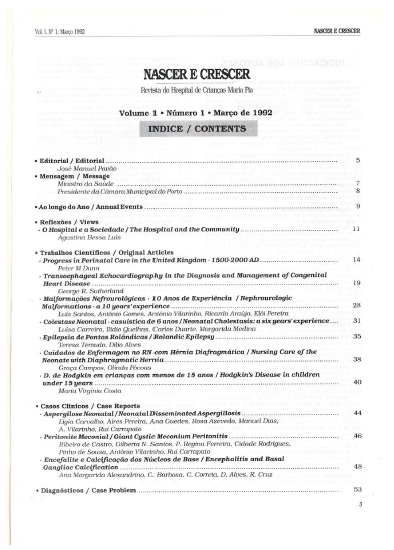“All men by nature desire knowledge“
Aristotle, Introduction to Metaphysics
The first edition of NASCER E CRESCER - BIRTH AND GROWTH MEDICAL JOURNAL was published in March 1992, by Hospital de Crianças Maria Pia, covering the entire field of pediatrics (fig 1, 2 and 3). It had the result of between pediatricians of all the hospitals in the North of Portugal and the Scientific Committee also included international experts from several pediatric specialties. At that time there were few national pediatric publications and the initiative to create this journal responded to the need of the pediatric community to share knowledge and promote post graduate education and scientific research to improve patient care and child health. It was a huge challenge but the editorial team was enthusiastic and committed to the development of the journal. Nascer e Crescer was the initial title, with four issues per year (March, June, September and December) and contents comprised original articles, review articles, case reports and opinion articles. Throughout its history, the journal has employed a rigorous double-blind peer review process to evaluate manuscripts for scientific accuracy, innovation and importance. It rapidly became one of the most widely read national pediatric journal.
Throughout the 30 years of regular publication the front page and layout have changed in order to improve readability, to facilitate key information and increase journal visibility.
We wish to emphasize some major historic milestones in its history:
The merging of Hospital de Crianças Maria Pia in the Centro Hospitalar Universitário do Porto in 2010 and the integration of Nascer e Crescer in the Department of Ensino, Formação e Investigação (DEFI) represented an opportunity for change and development with innovative solutions to improve the publication.
The aim and scope was enlarged to include maternal-fetal, neonatal and pediatric health, fostering collaboration between the various disciplines related to maternal and child care.
In 2011, the journal was indexed in the Scielo platform (Scientific Electronic Library Online)
This indexing gave access to all articles, increasing the journal visibility, impact and credibility.
The widespread of the internet and the evolution of digital technology transformed dramatically scientific publication: the pressure to move to on-line printing and the shift from subscription to open access (OA) models. The new technologies enable the communication of research more quickly, broadly and openly and provide resources (enhanced media, data, linked resources, etc) only possible in a digital form. Most of Medical Journals gradually moved from a printed format to a hybrid process (electronic and printed) or exclusively to online printing.
Concomitantly, the movement of OA based on the concept that medical and scientific knowledge should be widely shared to allow further and faster advances was embraced enthusiastically by academic institutions, medical researchers, libraries, the public and governments. The Budapest Open Access Initiative (February 2002), the Bethesda Statement on Open Access Publishing (June 2003), and the Berlin Declaration on Open Access to Knowledge in the Science and Humanities (October 2003), also mentioned as the BBB (3Bs), state essentially “that OA allows its users to read, download, copy, print, search, distribute, or link to the full text of works, permitting the use for any legitimate purpose, as long as access to the material is possible through the internet”.
OA was initially classified into two main categories: green and gold OA. Green OA allows free access to articles through institutional or central repositories, and in gold OA the articles are available on the publisher’s Web sites. However the author may be charged by the publisher and fees may be as high as € 9500 (journal Nature1), or the journal may establish an embargo of a 6 -12 months’ period to OA.
Currently, in spite of the strong benefits of OA towards science democratization, it also brings a new paradigm to the publishing practice: a shift of the financing path from the readers to the authors or their funders. The term “platinium” or “diamond” OA has emerged to indicate that there are no fees involved for the authors in order to make a clear distinction between these situations. There are now 17.550 journals registered in the Directory of Open Access Journals and 12.279 (70%) do not charge processing fees (https://www.doaj.org).
Nascer e Crescer also adhered to the movement of OA and electronic printing. In 2012 the publication was made openly available upon deposit in the Repository of Centro Hospitalar Universitário do Porto. The Journal was published in paper and hybrid mode until 2016 when it moved to online publication and embraced free OA policy without charging the processing fees to the authors in order to promote the sharing of knowledge and proximity to the scientific community. The expenses with editorial staff, typesetting and copyediting are still significant and the sustainability of Nascer e Crescer depends on institutional funding but also this guaranties that this scientific journal is independently generated and maintained.
Nascer e Crescer integrated the Scientific Open Access Repository of Portugal (RCAAP) particularly the Scientific Journal Hosting Service (SARC). The service provides a publication and management platform, including on line submission and manuscript tracking, through the website http://revistas.rcaap.pt/nascercrescer. Electronic submission substantially reduces editorial processing and shortens reviewing and overall publication times and allows monitoring by authors of the peer review process.
In 2017 we faced a new challenge: the publication in English language in order to increase the visibility of the publication and thereby enhance global communication and collaboration in the scientific community worldwide. The title of the Journal also reflected this evolution and was changed to Nascer e Crescer-Birth and Growth Medical Journal.
At present Nascer e Crescer- Birth and Growth Medical Journal is an electronic, open access peer-reviewed journal that publishes research articles, original articles, review articles, case reports and opinion articles on a broad range of topics related to maternal and child health.
The Editorial Board includes highly qualified professionals from across all the country committed to innovation and improvement of the scientific quality of the Journal. The specialized Section Editors have three main roles: journal development, peer review and journal advocacy. The Scientific Committee encompassesnational and international experts in maternal and child health. The Journal is indexed and summarized in some of the most important international databases of scientific papers: SciELO, DOAJ, REDIB, Embase/Excerpta Medica, Catálogo Latindex and Index das Revistas Médicas Portuguesas.
The future of medical publication will certainly continue to change, and present new challenges. As for Nascer e Crescer- Birth and Growth Medical Journal, with a distinguished 30-year history, we will pursue to maintain a high standard of content to address the scientific needs of our target audience and promote collaboration between the various disciplines interested in maternal and child health as well as cooperation with international researchers. We will strive to be included in Medline PubMed, PubMed Central, Scopus to increase visibility and readership and consequently attract more high quality submissions.
On behalf of our Editorial Board, Editors and Editorial Office we thank our Publisher for support, our reviewers whose guidance and advice represent a fundamental pillar in the quality of the Journal, our authors for the submission of their work and, last but not the least, our loyal and engaged readers.


















